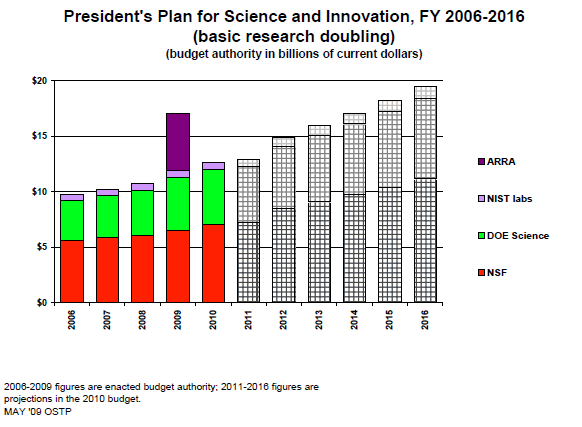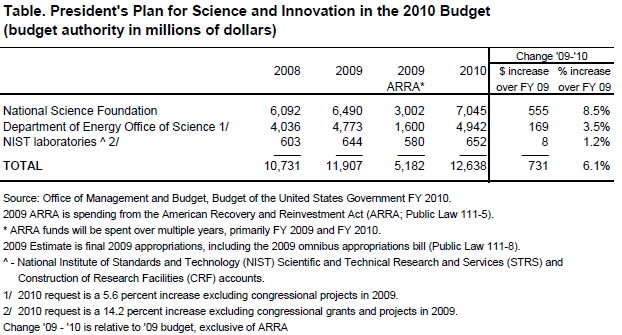|
|
|
|
|
|
|
News & Views item - August 2009 |
![]() US President Obama's Plan for Science and Innovation Doubling Funding for Key
Basic Research Agencies in the 2010 Budget
US President Obama's Plan for Science and Innovation Doubling Funding for Key
Basic Research Agencies in the 2010 Budget
The 2010 Budget sustains the Presidentís commitment to double the budgets for three key basic-research agencies over a decade. All monies in US$.
Building on investments in the Recovery Act and the 2009
Omnibus Appropriations Act, the 2010 Budget provides substantial increases in
funding for the National Science Foundation (NSF), the Department of Energyís
Office of Science (DOE SC), and the National Institute of Standards and
Technology (NIST) laboratories and establishes a clear path to completing the
doubling effort in 2016.

Federally supported basic research has been a reliable source
of new knowledge and new products. It has fuelled important developments in
fields ranging from telecommunications to transportation to medicine, and has
yielded positive rates of economic return by creating entirely new industries
with highly skilled, high-wage jobs. The Presidentís Plan for Science and
Innovation and the America COMPETES Act have identified NSF, DOE SC, and NIST as
key to our nationís prosperity and to preserving Americaís place as the world
leader in science and technology. Although the previous Administration voiced
support for efforts to double these agenciesí budgets between 2006 and 2016,
these efforts fell short in 2007 and 2008. In 2009, the American Recovery and
Reinvestment Act and the 2009 Omnibus Appropriations Act signed by President
Obama finally put these agencies back on a doubling trajectory.
The 2010 Budget builds on these early Administration
accomplishments with a requested $12.6 billion total for NSF, DOE SC, and
the NIST labs, an increase of $731 million or 6.1 percent above the 2009 enacted
total (excluding Recovery Act funds of $5.2 billion for the three agencies).
These substantial increases keep the agencies on track for the
fourth year of a ten-year doubling trajectory. In addition, the 2010 Budget
establishes projections laying out a clear path to completing the doubling
effort in 2016 with $19.5 billion for the three agencies, double the $9.7
billion they received in 2006. Between 2009 and 2016, the Obama Administrationís
enacted and proposed budgets would add $42.6 billion to the 2008 budgets for
these basic research agencies, with a special emphasis on encouraging high-risk,
high-return research and supporting researchers at the beginning of their
careers.
Basic Research Agencies in the Presidentís Plan for Science
and Innovation
The National Science Foundation (NSF) is the primary
source of support for academic research for most non-biomedical disciplines,
funding basic research across the entire spectrum of the sciences and
engineering. It is well regarded for funding nearly all of its research through
a competitive, peer-reviewed process. The increase in NSF funding to $7.0
billion in 2010, or 8.5 percent more than the 2009 enacted level, will support
many more researchers, students, post-doctoral fellows and technicians
contributing to the innovation enterprise. The 2010 Budget also is in line with
the Presidentís commitment to triple the number of NSFís Graduate Research
Fellowships to 3,000 by 2013
The Department of Energyís Office of Science supports
grants and infrastructure for a wide range of basic research that promises to
have a major impact on such economically significant areas as nanotechnology,
high end computing, energy, and climate change. The 2010 Budget of $4.9 billion,
or 3.5 percent more than the 2009 enacted level, increases funding for both
cutting-edge research and facilities. The 2010 DOE SC Budget will help us
improve our understanding of climate science, continue the U.S. commitment to
international science and energy experiments, and expand Federal support at the
frontiers of energy research.
The Department of Commerceís National Institute of
Standards and Technology (NIST) invests in technological innovation through
research, advanced measurement, and standards development. The 2010 Budget of
$652 million for NISTís intramural laboratories will improve NISTís research
capabilities by providing high-performance laboratory research and facilities
for a diverse portfolio of basic research in areas such as health information
technology, the digital smart grid, and carbon measurements. Separately, the
2010 Budget also sustains NISTís external programs, including $125 million in
2010 (a $15 million increase over the 2009 enacted level) for the Hollings
Manufacturing Extension Partnership (MEP) to enhance the competitiveness of the
nationís manufacturers.
